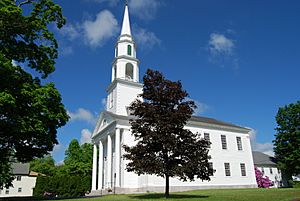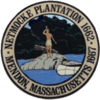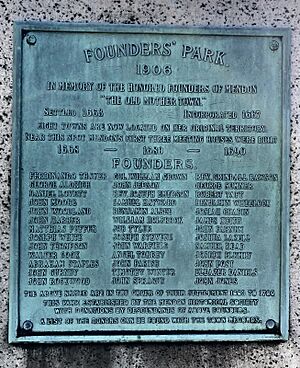Mendon, Massachusetts facts for kids
Quick facts for kids
Mendon, Massachusetts
|
||
|---|---|---|

First Church, Mendon
|
||
|
||

Location in Worcester County and the state of Massachusetts.
|
||
| Country | United States | |
| State | Massachusetts | |
| County | Worcester | |
| Settled | 1660 | |
| Incorporated | May 15, 1667 | |
| Government | ||
| • Type | Open town meeting | |
| Area | ||
| • Total | 18.3 sq mi (47.3 km2) | |
| • Land | 18.1 sq mi (46.9 km2) | |
| • Water | 0.2 sq mi (0.4 km2) | |
| Elevation | 330 ft (101 m) | |
| Population
(2020)
|
||
| • Total | 6,228 | |
| • Density | 344.1/sq mi (132.8/km2) | |
| Time zone | UTC-5 (Eastern) | |
| • Summer (DST) | UTC-4 (Eastern) | |
| ZIP code |
01756
|
|
| Area code(s) | 508 / 774 | |
| FIPS code | 25-40255 | |
| GNIS feature ID | 0618371 | |
| Website | http://mendonma.gov/ | |
Mendon is a town in Worcester County, Massachusetts, United States. In 2020, about 6,228 people lived there. Mendon is part of the Blackstone River Valley National Heritage Corridor. This area was an important center for the start of the Industrial Revolution in America. Mendon celebrated its 350th birthday on May 15, 2017.
Contents
History of Mendon
Early Days and Native Americans
Long before Europeans arrived, Native Americans lived in the Mendon area for thousands of years. The Nipmuc people lived here when the first Europeans came. Nipmuc Pond is named after them. The word Nipmuc means "small pond place" or "people of the fresh waters."
The Nipmuc were not just one tribe, but a group of native people who lived across central Massachusetts. Today, over 500 Nipmuc people live in Massachusetts. They had their own written language, tools, and farmed crops like corn, beans, and squash.
In the early 1600s, some Native Americans became Christians. They were called "Praying Indians" and lived in special villages called "Praying Towns." Two of these villages were in Mendon, in an area that later became Uxbridge. A missionary named John Eliot helped set up these villages. He even translated the Bible into the Nipmuc language.
Pioneer Settlers Arrive
In 1662, pioneers from Braintree asked for a large piece of land. They bought this land, about 8 miles square, from two Native American chiefs, "Great John" and Quashaamit, for 24 pounds. This was the start of Mendon. Some unofficial settlers had already been here since the 1640s.
The area was first called "Squinshepauke Plantation." It officially became the town of Mendon in 1667. The settlers worked hard to clear roads and build their new community.
Mendon was first part of Middlesex County in 1667, then Suffolk County in 1671, and finally Worcester County from 1731. Mendon was first settled in 1660 and became a town in 1667. The original town was very large, about 64 square miles. It included parts of what are now the towns of Milford, Bellingham, Hopedale, Uxbridge, Upton, Blackstone, Northbridge, and Millville. Because of this, Mendon is sometimes called "Mother Mendon."
In 1664, Benjamin Albee built the first water-powered mill in the area on the Mill River. This mill was very important for the early town.
King Philip's War and Rebuilding
On July 14, 1675, the King Philip's War began in Mendon. Several settlers were killed, and Albee's mill was destroyed. These were the first settlers killed in this war in the Massachusetts Colony. The town was mostly burned down in early 1676. Many Nipmuc people were also affected by the war. Mendon was rebuilt in 1680.
After the war, Robert Taft, Sr. settled in Mendon in 1680. He was the ancestor of the famous Taft family. In 1712, Lydia Taft was born in Mendon. She became America's first woman to legally vote. Ezra T. Benson, a famous Mormon missionary and legislator, was also born here. The Taft family became a well-known political family in America.
Another important American family, the Aldrich family, also started in Mendon. Their descendants include Senator Nelson Aldrich, who helped create the Federal Reserve Bank, and Vice President Nelson Aldrich Rockefeller.
Colonial and Revolutionary Times
Mendon eventually rebuilt and became a stop along Boston's Middle Post Road, which is now Route 16. A milestone from 1772, marking 37 miles from Boston, still stands today. In 1719, Bellingham became the first community to separate from Mendon and form its own town. It is said that in 1789, President George Washington was refused a room in Mendon by an innkeeper's wife during his journey.
Modern Mendon Today
In the early 1900s, Lake Nipmuc Park was a popular resort with music and shows.
The famous rock band Aerosmith played their very first concert in Mendon on November 6, 1970, at Nipmuc Regional High School (which is now Miscoe Hill Middle School). Mendon is also home to two Boy Scout troops.
Mendon and the nearby town of Upton share a school district called the Mendon Upton Regional School District (MURSD). They have separate elementary schools, but students from both towns attend Miscoe Hill Middle School and Nipmuc Regional High School together. Nipmuc Regional High School was recently named one of the top 500 schools in the United States.
In 1986, the U.S. Congress created the Blackstone River Valley National Heritage Corridor, a national park. Mendon is located within this park. Today, Mendon is mostly a residential town, but it has seen some new businesses along Route 16. Southwick's Zoo in Mendon is the largest zoo in Massachusetts. The Mendon Twin Drive-In is also in Mendon, and it's one of only three drive-in movie theaters left in Massachusetts.
Geography of Mendon
Mendon covers about 18.3 square miles. Most of this area, about 18.1 square miles, is land. The rest, about 0.2 square miles, is water.
Neighboring Towns
 |
Upton | Hopedale |  |
|
| Northbridge Uxbridge |
Bellingham | |||
| Uxbridge | Millville, Blackstone | Bellingham |
Population Information
| Historical population | ||
|---|---|---|
| Year | Pop. | ±% |
| 1850 | 1,300 | — |
| 1860 | 1,351 | +3.9% |
| 1870 | 1,175 | −13.0% |
| 1880 | 1,094 | −6.9% |
| 1890 | 919 | −16.0% |
| 1900 | 911 | −0.9% |
| 1910 | 880 | −3.4% |
| 1920 | 961 | +9.2% |
| 1930 | 1,107 | +15.2% |
| 1940 | 1,315 | +18.8% |
| 1950 | 1,619 | +23.1% |
| 1960 | 2,068 | +27.7% |
| 1970 | 2,524 | +22.1% |
| 1980 | 3,108 | +23.1% |
| 1990 | 4,010 | +29.0% |
| 2000 | 5,286 | +31.8% |
| 2010 | 5,839 | +10.5% |
| 2020 | 6,228 | +6.7% |
| 2023* | 6,331 | +1.7% |
| * = population estimate. Source: United States Census records and Population Estimates Program data. |
||
In 2000, there were 5,286 people living in Mendon. There were 1,815 households, and 1,450 families. About 42.2% of households had children under 18 living with them. The average household had about 2.90 people.
The population was spread out by age:
- 29.5% were under 18 years old.
- 32.7% were between 25 and 44 years old.
- 8.4% were 65 years or older.
The average age in Mendon was 37 years.
Taft Public Library
Mendon's Taft Public Library was started in 1881. In 2016, a new library building was completed.
Fun Places to Visit
- Mendon Twin Drive-In
- Southwick's Zoo
- Historic walking tour of Mendon
- Mendon Airport (private)
- Mendon Town Beach
Historic Places to See
- Mendon Center Historic District
- Nathan C. Aldrich House and Resthaven Chapel
- North Avenue Rural Historic District
- Olney Cook Artisan Shop
Local News
- The Upton and Mendon Town Crier newspaper is published twice a month. It is sent for free to all homes in Mendon and Upton.
- The Milford Daily News is the closest daily newspaper.
Famous People from Mendon
- Benjamin Adams (1764–1837), a U.S. Congressman.
- Adin Ballou (1803–1890), a social reformer and pacifist who led Mendon's Unitarian Church.
- Ezra T. Benson (1811–1869), a Mormon pioneer born in Mendon.
- Adin B. Capron (1841–1911), a U.S. Congressman.
- Albert Harkness (1822–1907), a scholar and educator.
- Lydia Taft (1712–1778), America's first woman voter, born in Mendon.
- Eli Thayer (1819–1899), an abolitionist congressman and founder of Oread Institute.
- Armenia S. White (1817–1916), a suffragette and social reformer.
Gallery
See also
 In Spanish: Mendon (Massachusetts) para niños
In Spanish: Mendon (Massachusetts) para niños




